#scallops
Explore tagged Tumblr posts
Text
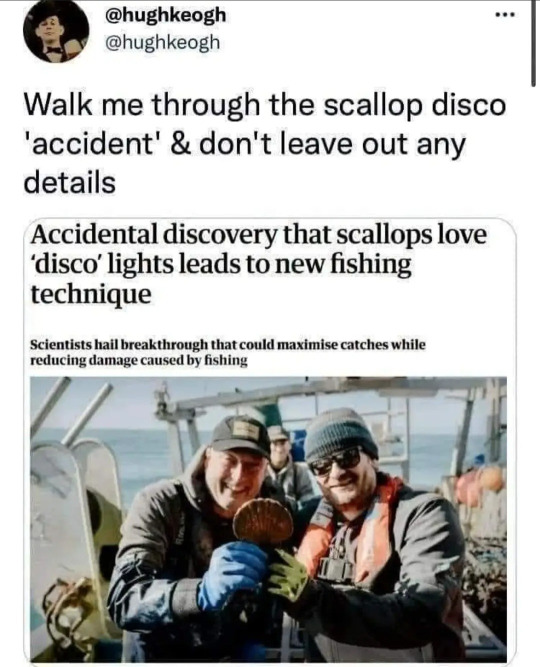
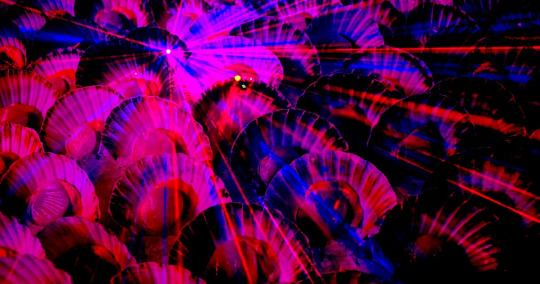
2K notes
·
View notes
Text
String identified: t tt t c a ca a. tg a at t. ag. g. t a a t t cct a t t ct t a t a
Closest match: Mimachlamys varia genome assembly, chromosome: 4 Common name: Variegated Scallop
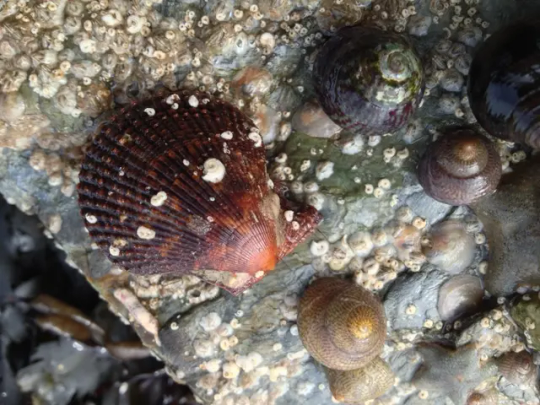
(image source)
i love the little pretend economies people make up on social media. investing early at 200 notes. meaningless. very good. used to derive a similar sense of mirth from the concept of rare pepes until the crypto dipshits made those real
#tumblr genetics#genetics#biology#science#orteil42#molluscs#scallops#variegated scallop#these guys change sex several times over the course of their development#until eventually becoming male once fully grown
4K notes
·
View notes
Text
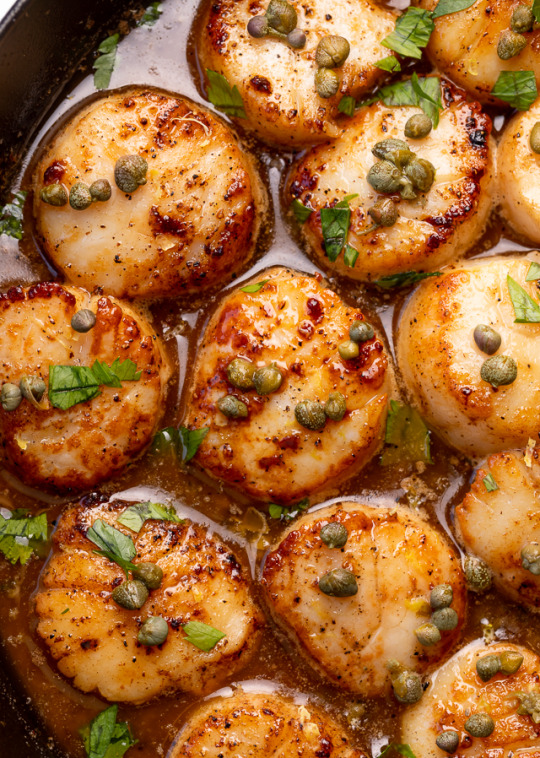
pan seared scallops lemon butter caper sauce
423 notes
·
View notes
Text
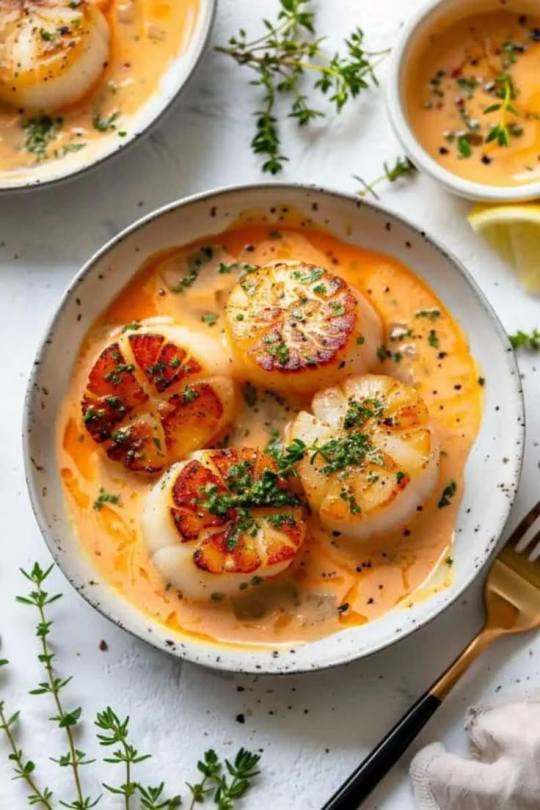
292 notes
·
View notes
Photo
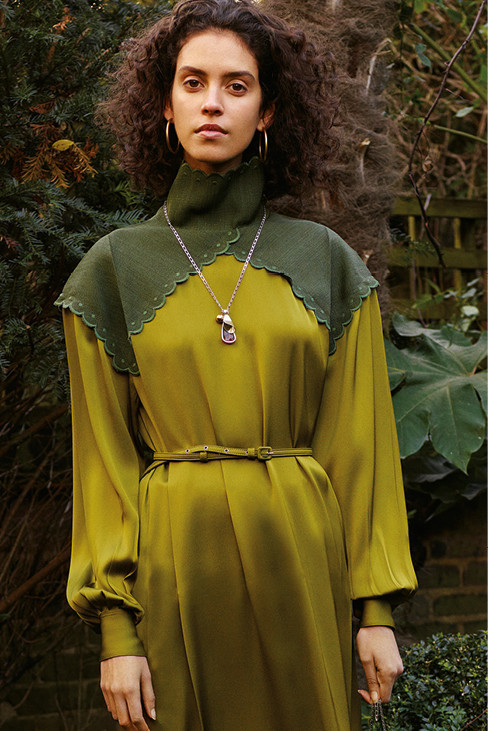
Celine Fall 2016
#celine#celine aw16#cm: green#collars#embroidery#scallops#accessories#sleeves#silk#fairytale#medieval#scarves#autumn#styling details
20 notes
·
View notes
Text

Scallops for Supper - Felicity House , 2020.
British , b. 1950 -
Pastel . 25 x 30 cm.
185 notes
·
View notes
Text
Paradise

29 notes
·
View notes
Text
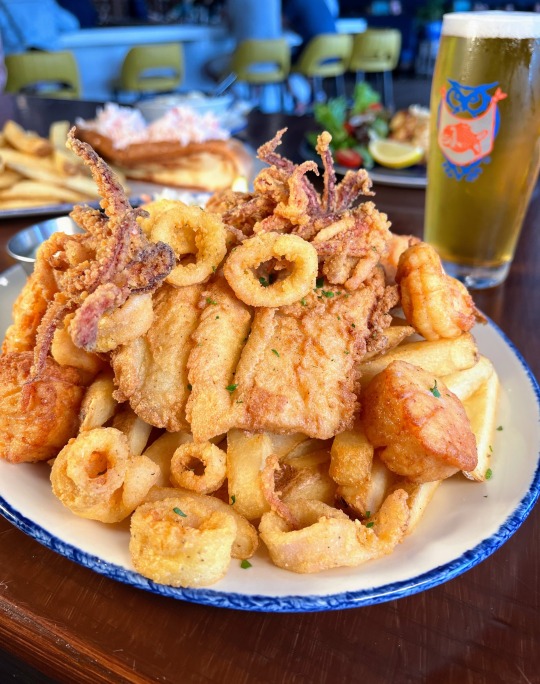
Fisherman's Platter | Legal Sea Foods
1K notes
·
View notes
Photo

~ Fuchsia ~
84 notes
·
View notes
Text

533 notes
·
View notes
Photo

Hanna Verhees by Christopher Fenner for Hello! Fashion
73 notes
·
View notes
Text
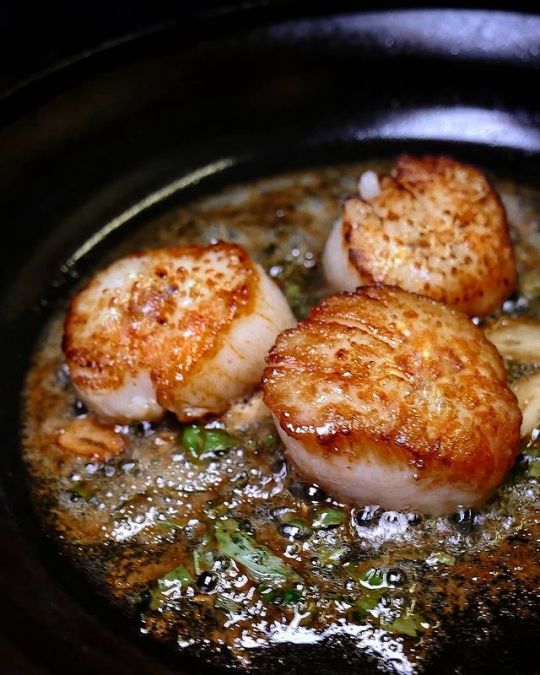
seared scallops from @omgitsbomb on ig
125 notes
·
View notes
Photo

Seared Scallops with Lemon Garlic Butter Indulge in the delightful taste of perfectly seared scallops drizzled with a zesty lemon garlic butter sauce. This dish is a quick yet elegant option for any seafood lover. Ingredients 1 1/4 lb sea scallops side muscle removed 1 1/2 tablespoons olive oil or canola oil 3 tablespoons butter 1-2 cloves of garlic minced 2 tablespoons fresh lemon juice 2 teaspoons chopped fresh parsley or other fresh herbs Salt and fresh ground black pepper Instructions Pat the scallops dry with paper towels and sprinkle with a pinch of sea salt just before cooking. In a large sauté pan or cast iron skillet, heat olive oil and 1 tablespoon of butter over medium-high heat until hot and nearly smoking. Add the scallops and sear for 1 1/2 to 2 minutes on each side until they develop a golden crust. Avoid overcrowding the pan; cook in batches if necessary. Once cooked, remove scallops to a plate. Carefully wipe out the skillet, then add the remaining 2 tablespoons of butter over low heat. Add the minced garlic and sauté until fragrant, about 1 minute. Pour in the lemon juice and return the scallops to the pan. Warm the scallops for 1-2 minutes, turning several times to coat them in the lemon butter. Sprinkle with parsley, salt, and pepper to taste, and serve immediately.
#SeafoodDelight#Scallops#LemonGarlicButter#QuickDinner#ElegantMeal#cooking#food#kitchen#recipes#snack#foodie#foodpics#bread#baking#recipe#chocolate#dinner#breakfast#lunch#foodmyheart#appetizer#desert
91 notes
·
View notes
Text
Wet Beast Wednesday: scallops
I may have only discussed them once before on this series, but I'm not saying "bye" to bivalves. One of the coolest bivalve subgroups are the scallops. While most Bivalves live in one spot their entire lives, scallops boldly go where no clam has gone before and take to the seas, actively swimming.
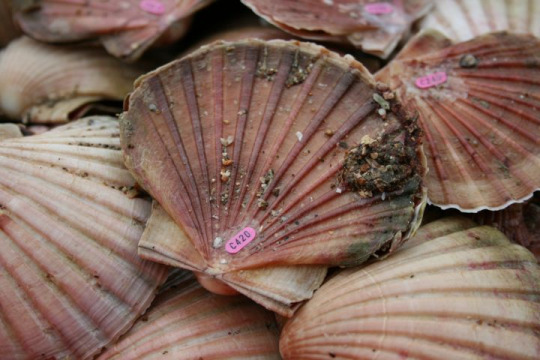
(Image: a pile of captured scallops. They are bivalves with shells shaped like hand fans with two wing-like structures near the hinge. The shells have ridges running from the hinge to the outer edge. Small pink ID tags have been glued to them. End ID)
Scallops are members of the family Pectinidae. As with all bivalves, they have two shells that interlock with a pair of valves which form hinges. The two shells are not identical. Most scallops prefer to rest on one valve (usually the right one), which results in that shell growing more rounded than the other one. Growing from the back of the shell near the hinge are two structures called wings, ears, or auricles, which are unique to scallops. Another shell feature unique to scallops is the ctenolium, a honeycomb shaped structure that is used to help distrubute byssal threads. Byssal threads are structures found in most bivalves. They are strong and sticky filaments that attach bivalves to rocks. Most scallops only attach themselves to rocks as juveniles and lose the ctenolium as adults. The scallops shell has a distinctive and usually symmetrical shape. Many have distinctive ridges running from hinge to the front of the shell. These are supported by structures called ribs. These provide extra integrity to the shell, but increase weight, requiring an evolutionary balancing act to get the most benefit out of them.
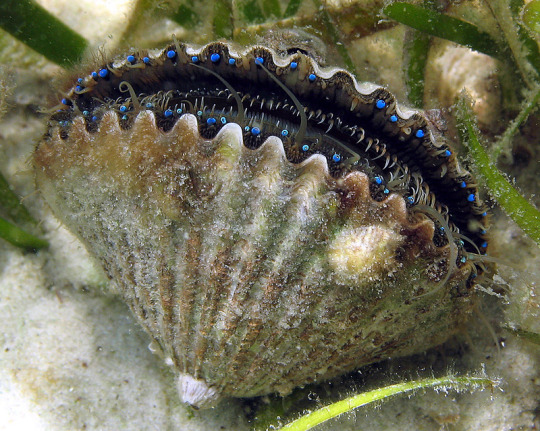
(Image: a live scallop with the opening facing the camera. Inside the shell is a fleshy structure with multiple small tentacles and two rows of small, blue eyes. There is algae and a barnacle growing on the shell. End ID)
The inside of the shell contains the body of the scallop. A large portion of the interior is taken up by the adductor muscle, which attaches to the inside of both shells. The adductor muscle of scallops is larger and more developed than those found in most bivalves. In all bivalve species, its purpose is to close the shells. Scallops also use it for swimming. The scallop adductor muscle is made of both smooth and striated muscle tissue. The striated muscle moves fast but tires out quicker and is sued for rapidly opening and closing the shell when swimming. The smooth muscle is slower but uses much less energy, allowing the scallop to hold its shell closed for a long time. As with all bivalves, the shell defaults to the open position thanks to a structure called the hinge ligament and require active muscle contraction to close. Most of the rest of the body is the digestive system, reproductive system, circulatory system, and nervous system. The nervous system is a fairly simple nerve net and lacks a brain. Unlike most bivalves, scallops do not intake food through a siphon. Instead, they open their shells to let water move over a structure that filters out food particles and imbeds them in mucus. cilia then moves the mucus into the mouth and through the digestive system. The digestive system also passes through the heart. Around the opening of the shell is a structure called the mantle. The mantle is lined with tentacles that help filter out inedible things from the water.
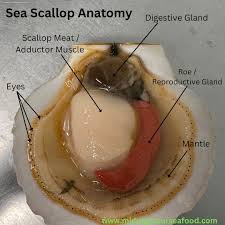
(image: a scallop with one shell removed to show the internal anatomy. End ID)
Also along the mantle are two rows of eyes, one for each shell and up to 200 in total. Most bivalves don't have eyes. Scallops, being swimming animals, do have eyes and they are strange, not just in comparison to vertebrate eyes, but in comparison to the eyes of other mollusks. Each eyeball has a lens, a pupil, two retinas, and at the back, a system of mirrors that direct and focus light in a similar manner as telescopes. The mirrors are composed of guanine (the same stuff as the "G" nucleotide in DNA) and are shaped like convex squares. There can be over 100,000 mirrors in each eye. For a long time, it was thought that the proximity of the mirrors to the retinas would result in an unfocused, blurry image. It has recently beed discovered that the cells that eye can change shape, potentially adjusting the mirrors for a sharper image. Scallops also have more opsins (light-sensing proteins in the retina) than humans and they may not be evenly distributed, potentially allowing different eyes to see different parts of the light spectrum. While it's not clear how much information the scallops can interpret with their lack of a brain, they at least can tell the difference between ares of contrast and can detect motion. Scallops seem to mainly use their vision to detect predators and to adjust their swimming and feeding behavior.
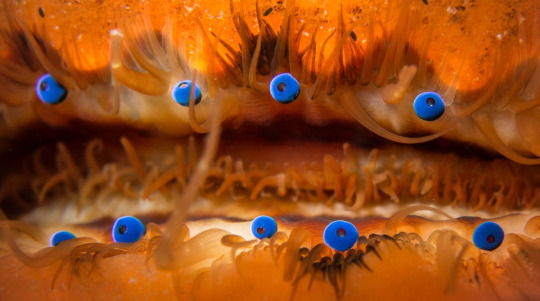
(Image: a close-up shot of scallop eyes. They are blue balls with a black pupil. End ID)
Now for the reason Spongebob turned scallops into the undersea equivalent of birds. Unlike the vast majority of bivalves, who are either immobile or bury themselves in the sediment, scallops are free-swimming. At least most of them, there are some species that live their lives attached to rock or another structure, like mussels or oysters. The body plan of scallop shells is adapted to facilitate swimming. They have two main means of locomotion called swimming and jumping. Both involve the scallop opening the shell to intake water, then rapidly closing it to force the water out. While swimming, the water is ejected through small holes near the hinge called exhalant apertures. The water is forced over the shell's wings and can be sent out over the left or right wing. Most of the time, they will alternate which wing the water is pushed over, resulting in a zig-zag movement. In jumping, the water is forced out the way it came, propelling the scallop backwards. It usually comes to a rest on the sediment between jumps. Both swimming and jumping cost a lot of energy and the scallop will have to rest afterwards. their locomotion is used to avoid predation, with starfish being their main predators. Some species also have a muscular foot that can extend from the shell and is used to bury the scallop.
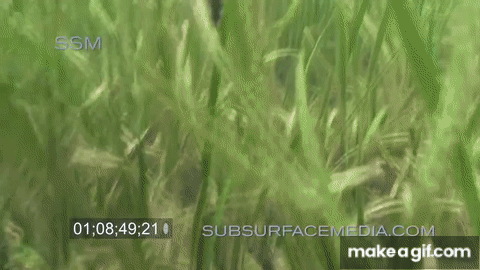
(Gif: a scallop swimming over a field of seagrass, showing off the zig-zag motion and its ability to alter its course. End ID)
Some species of scallop are dioecious, meaning they have distinct males and females. Others are simultaneous hermaphrodites while still others are protandrous sequential hermaphrodites, beginning their lives as males and becoming females when they get older. Their reproductive organs are called roe and are red in females and white in males. Scallops are broadcast spawners. They release eggs and sperm into the water column. After a few weeks, fertilized eggs will hatch into drifting larvae called spat. Spat look like miniature, transparent versions of the adults. As they age, the spat will drop to the seafloor. This event has the delightful name of spatfall. The spat use byssal threads to attach themselves to whatever they can find and will remain like that until they have matured. Most species lose their byssal threads as adults, but a few retain them and do not become swimmers. Depending on species, scallops can live for up to 20 years.
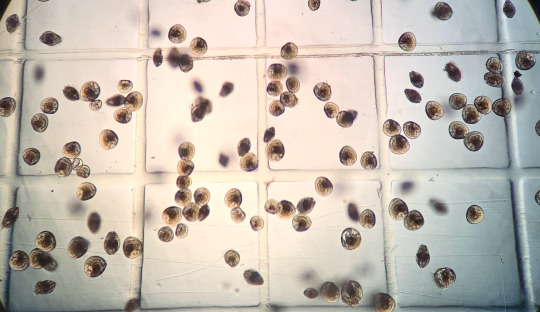
(Image: a group of spat housed in captivity They are smaller, transluscent versions of the adults. End ID)
The part of scallops that people usually eat is the adductor muscle, though the roe is also edible. Scallops have been eaten by various peoples for millennia and excessive catching has caused severe declines in wild populations. This has led to the rise of many aquaculture methods for growing scallops from the spat stage. Because scallops are filter feeders, they improve local water quality and when their numbers diminish, water quality worsens. On the other hand, when massive numbers of scallops are raised together in aquaculture, they can cause localized eutrophication, an increase of nutrients that triggers massive microbe growth and reduces oxygen levels in the water. Dredging, the main method of capturing wild scallops, destroys benthic ecosystems, which can take decades to be restored. All of this for a food that tastes like congealed air.
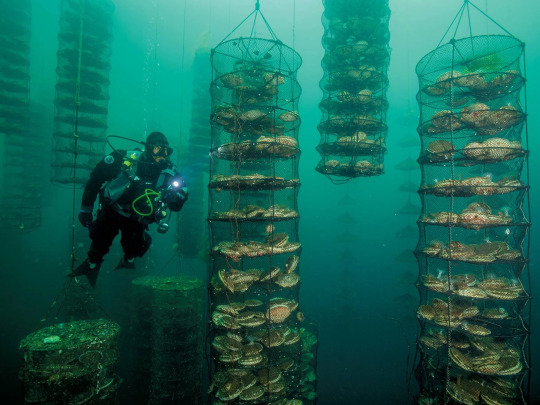
(Image: a scallop aquaculture setup. It consists of multiple nets hanging from the surface of the water, each separated into multiple layers holding multiple scallops. A SCUBA diver is swimming through the area. End ID)
#wet beast wednesday#scallop#scallops#bivalve#mollusk#molluscs#marine biology#biology#zoology#ecology#animal facts#informative#educational#image described
199 notes
·
View notes
Text
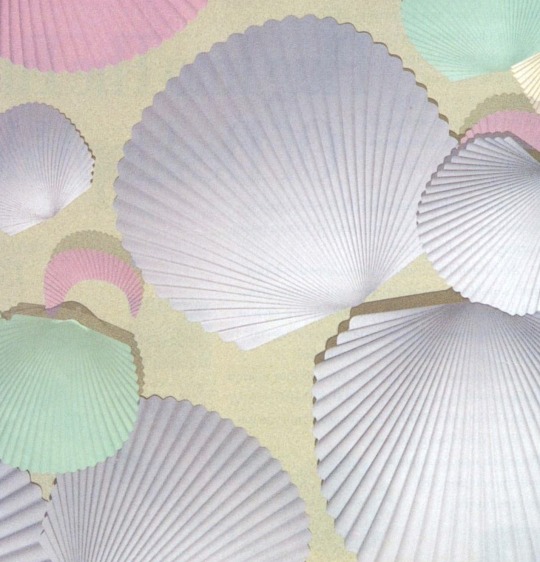
Computer Graphics World (1993)
209 notes
·
View notes
